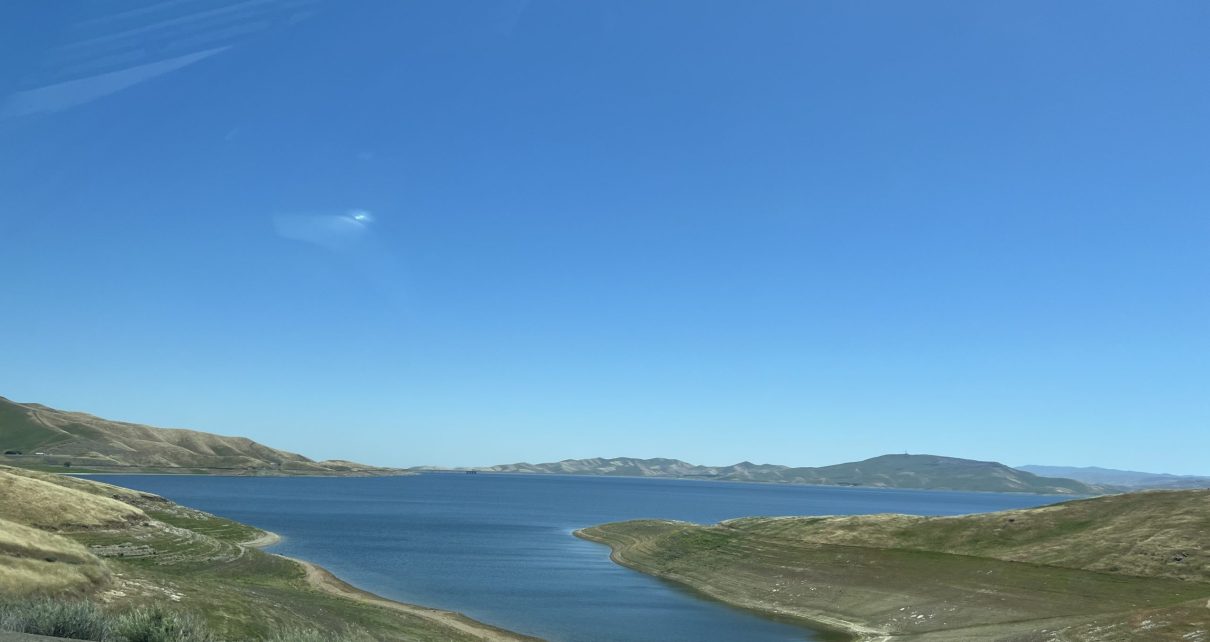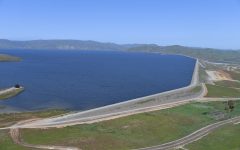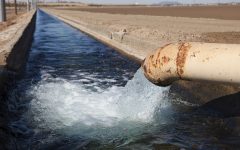
California San Luis Reservoir. (Photo: Katy Grimes for California Globe, April 2024)
Ringside: The Abundance Mindset
It is a political choice to impose scarcity on Californians that has created chronic water scarcity, along with scarcity of everything else
By Edward Ring, May 30, 2024 2:45 am
 If energy powers modern civilization, then water gives it life. And in California, for at least the last 20 years, with escalating severity, life has been tough. There isn’t enough water to go around.
If energy powers modern civilization, then water gives it life. And in California, for at least the last 20 years, with escalating severity, life has been tough. There isn’t enough water to go around.
Water scarcity is not being forced upon Californians by climate change. Like so many other fundamental challenges Californians must endure – energy scarcity, catastrophic wildfires, and unaffordable housing — the problem is mismanagement. Investment in water and energy infrastructure would increase the supply and lower the cost for energy and water. Investment in the timber industry would restore health to California’s forests at the same time as it would increase the supply and lower the cost for lumber. If all of this happened, the consequence would be lower costs for three of the most essential variables affecting the price of home construction.
Scarcity of essentials in California is also not from a lack of financial wherewithal. Californians today have chosen to spend taxpayer revenues on welfare and entitlements and a bureaucracy that could probably be cut in half without sacrificing services. In a different era, California’s state government invested orders of magnitude more funds in energy, water, and transportation infrastructure. In turn, that enabled the private sector to capitalize on low cost inputs to create jobs that easily paid enough for employees to support families in an economy that had an affordable cost-of-living.
Ultimately, it is a political choice to impose scarcity on Californians that has created chronic water scarcity, along with scarcity of everything else essential to enabling working families to live with a decent quality of life. Californians must rediscover the abundance mindset that between 1950 and 1970 made this state the most affordable and opportunity rich place in the world.
Much of the blame for this can be attributed to an environmentalist movement that has become a self-serving industry. But the environmentalist political machine, hiding behind armies of thoroughly indoctrinated activists, itself gives cover to business interests with products and services that depend on environmentalist mandates, to financial special interests that profit from scarcity and asset inflation, and to government bureaucrats that grow their organizations every time another environmentalist regulation has to be enforced.
Today in California, “solutions” to water scarcity that are politically acceptable are either impractical, expensive, or merely impose new restrictions on water use. Often these “solutions” involve all three, as epitomized by SB 1157 by former Senator Robert Hertzberg (D-Los Angeles), which lowers permissible indoor water use to 42 gallons per person per day by 2030, and requires every square foot of outdoor landscaping to adhere to “water budget” guidelines. This horrifically intrusive new law will cost an estimated $7 billion to implement, along with ongoing enforcement costs. The total projected water savings? Around 400,000 acre feet per year.
This absurdly trivial reduction in water consumption, at great cost and great annoyance to consumers, ignores the fact that Californians divert over 60 million acre feet of water even in dry years, which means that ratepayers and taxpayers will be spending $7 billion to reduce overall water use by less than one percent. SB 1157 also ignores the fact that the state has already done a tremendous job conserving water. California’s farmers have doubled their productivity per unit of water over the past 30 years while using the same total amount of water. They were using about 30 million acre feet per year back in the 90s; they’re still only using 30 million acre feet. Total water use per year in California’s cities has dropped from 9 million acre feet in the late 1990s to 7.5 million acre feet today. The last time California’s urban water consumption was only 7.5 million acre feet was in the 1980s, when only 25 million people lived here.
The consequences of SB 1157 are all negative. By effectively rationing the amount urban water districts can supply to their customers, the incentive for these agencies to invest in new water supply projects will be taken away. And because most of the amounts in the bills that water districts send to their customers are for fixed overhead and to pay back bonds used to finance existing infrastructure, as usage is forced down, the cost per unit of water consumed will have to rise to make up the difference. Customers will use less water, but they will not realize any savings. They will, however, have to purchase costly new appliances that don’t work very well and don’t last very long. Enforcement will be costly and annoying. And as residential landscapes are converted into hideous “xeriscapes,” the heat island impacts will further reduce urban quality of life.
An abundance mentality is the cultural solution that must precede any meaningful revision to California’s water policies. Water abundance is feasible and sustainable. There are plenty of solutions that respect the environment and prepare for whatever climate change may actually occur. Urban runoff harvesting. Wastewater recycling. Surface storage and aquifer storage. Fish-friendly delta diversions. Desalination. Within these categories are countless project opportunities that have the potential to add millions of acre feet per year to California’s water supply.
Breaking the special interest consensus that favors rationing can only be achieved if California’s electorate realizes that water allocations don’t have to be a zero sum game. It isn’t farms against cities. It isn’t even farms and cities against legitimate environmental needs. The problem is that Californians, for a host of reasons both noble and craven, have been convinced that sacrifice and scarcity are the only responsible responses to environmental challenges. That is absolutely false.
It is time for Californians to recognize that an abundance mentality does not have to compromise a commitment to environmental stewardship, and recognize they deserve to live in a state where water – along with energy and housing – are abundant and affordable. Only then will Californians be able to successfully demand the profound legislative, regulatory, legal, and financial reforms needed to rebuild their state and restore their dreams.
- Ringside: CA GOP Just Blew $46 Million for Nothing – Here’s How They Can Avoid Repeating That Mistake in 2026 - December 24, 2025
- Ringside: Will the Delta Pumps Operate at Capacity this Winter? - December 18, 2025
- Ringside: Will Advocates for More Water Supply Projects Find Unity? - December 11, 2025





Along with a cultural mindset change California also needs a spiritual “mindset” change. The abundance that California enjoys has been provided by God. As stewards of God’s provision we are tasked with managing it correctly. As your article points out we have mismanaged this blessing. A return to Godly values and stewardship will bring about better days.
Very true, and true for the whole United States of America. How different everything would be if we followed God and His Word.
Water scarcity, energy scarcity, catastrophic wildfires, and unaffordable housing are being deliberately mismanaged by Newsom and the criminal Democrat mafia that has a stranglehold of power in the state and the likely reason is to have more control over Californians? How to pry them out of power?